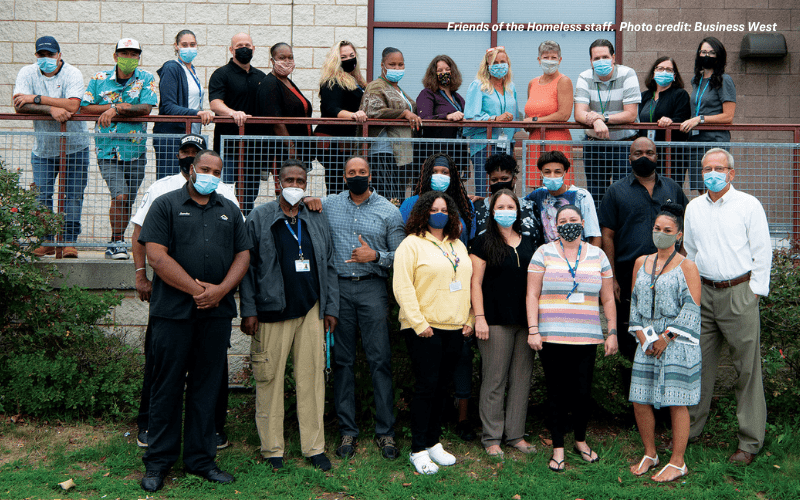December 17, 2020 Community Stories
A Safe Haven During COVID-19
How do you keep 200 people safe from COVID-19 when they’re sleeping next to each other in dorm-style bunk beds?
That was just one of the challenges facing Friends of the Homeless (FOH) in Springfield as the pandemic reached its doors.
Karin Jeffers, CEO of Clinical and Support Options, which runs FOH, reflected on the staff, “I imagine they were scared—as all of us were. But we didn’t have people calling in sick for work or refusing to go into the shelter to do their jobs. They showed up every single day and took care of themselves and the people who needed them.”

The sprawling campus includes 160 units of independent living apartments. Separate living quarters for women and men include showers and safe sleeping areas for another 200 people. Health clinics, dentistry, a cafeteria space, mental health and addiction treatment. A resource center staffed by case managers connect people to permanent housing, health insurance, food stamps, job postings, and job skills.
“Particularly over the last four years,” said Jeffers, “we’ve been able to completely change what a homeless shelter looks like. It’s a fully integrated service delivery system now, not just a place where somebody checks in to sleep.”
A broad spectrum of the community seek out FOH services—young adults, elderly people, LGBTQ, employed and unemployed of all ethnicities. Yet, said Jeffers, “Nobody who walks through our doors wants to be in a shelter here. We are their last resort.”
During COVID-19, according to Jeffers, “We were as essential as hospital emergency rooms to avoid a massive outbreak in Springfield among people experiencing homelessness.”
The City of Springfield joined forces quickly, and helped erect three separate, large medical tents directly across from the FOH campus. There, individuals needing quarantine or isolation could be out of the shelter’s general population (and the community).
In two weeks time, Clinical and Support Options hired more than 50 nurses and medical technicians to staff the tents around the clock from March through the end of the summer. Up went picnic tables for outdoor socially-distanced meals, hand sanitizing stations, plexiglass, PPE, homemade barriers between beds made out of shower curtains and PVC piping.
Some beds were moved from the dorms to the overflow areas in the resource center. Volunteers made (and donated) hundreds of cloth masks. The National Guard helped with security. They served three meals daily for more than 150 people per meal.
“We did it—for the entire city’s homeless population—without a single COVID infection on campus. It was an amazing effort of collaboration and support for a population that was extremely vulnerable,” Jeffers said.
A grant from the COVID-19 Response Fund through the Community Foundation made a difference.
Said Jeffers, “I can’t tell you how important the grant was. It allowed us to adapt quickly in getting all the safety supplies and staffing in place for the tents to be up and running. We didn’t have to wonder how we were going to pay for it; we could just do it.”
With unemployment benefits waning and housing protections reversed, evictions are predicted to push more vulnerable people into homelessness. Jeffers and her team are planning for that now—and for the long-term socioeconomic effects that will likely remain.